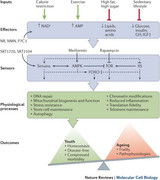While resveratrol and fisetin and metformin and other sirtuin-activating compounds only activate SIRT1, NAD precursors like NMN have the potential to activate all seven of the sirtuins.

Here I would like to briefly just post how sirtuins protect us from the following pathologies:
1. Diabetes
2. Non-alcoholic fatty liver disease
3. Atherosclerosis
4. Alzheimer’s disease
5. Retinal degeneration
6. Depression


